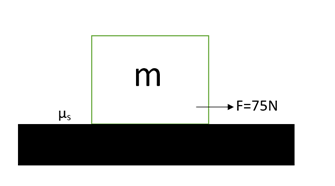
A $20kg$ block will be kept initially at rest on a rough horizontal surface. A horizontal force of $75N$ is needed to set the block in motion. After it is in motion, a horizontal force of $60N$ will be needed to keep the block moving with a fixed speed. What will be the coefficient of static friction?
$\begin{align}
& A.0.6 \\
& B.0.44 \\
& C.0.52 \\
& D.0.38 \\
\end{align}$
Answer
554.4k+ views
Hint: The horizontal force acting up to which the body will remain at rest can be found by taking the product of the mass of the block, coefficient of static friction and the acceleration due to gravity. Substitute the values in the equation and rearrange it. This will help you in answering this question.
Complete answer:
First of all let us mention what all are given in the question. The mass of the block mentioned in the question has been given as,
$m=20kg$
The horizontal force acting up to which the body will remain at rest has been mentioned as,
$F=75N$
The acceleration due to gravity has been given as,
$g=9.8m{{s}^{-2}}$
The horizontal force acting up to which the body will remain at rest can be found by taking the product of the mass of the block, coefficient of static friction and the acceleration due to gravity. This can be written as an equation given as,
$F={{\mu }_{s}}mg$
Rearranging this equation can be shown as,
${{\mu }_{s}}=\dfrac{F}{mg}$
Substituting the values in the equation can be written as,
${{\mu }_{s}}=\dfrac{75}{20\times 9.8}=0.382$
Therefore the coefficient of the static friction has been calculated.
The correct answer has been mentioned as option D.

Note:
The coefficient of static friction has been used often in order to measure the roughness of the surface. It can be mathematically shown as the ratio of applied force to the normal reaction. The magnitude of the frictional force will be dependent on two factors. One will be how heavy the material is and how rough the surface is.
Complete answer:
First of all let us mention what all are given in the question. The mass of the block mentioned in the question has been given as,
$m=20kg$
The horizontal force acting up to which the body will remain at rest has been mentioned as,
$F=75N$
The acceleration due to gravity has been given as,
$g=9.8m{{s}^{-2}}$
The horizontal force acting up to which the body will remain at rest can be found by taking the product of the mass of the block, coefficient of static friction and the acceleration due to gravity. This can be written as an equation given as,
$F={{\mu }_{s}}mg$
Rearranging this equation can be shown as,
${{\mu }_{s}}=\dfrac{F}{mg}$
Substituting the values in the equation can be written as,
${{\mu }_{s}}=\dfrac{75}{20\times 9.8}=0.382$
Therefore the coefficient of the static friction has been calculated.
The correct answer has been mentioned as option D.

Note:
The coefficient of static friction has been used often in order to measure the roughness of the surface. It can be mathematically shown as the ratio of applied force to the normal reaction. The magnitude of the frictional force will be dependent on two factors. One will be how heavy the material is and how rough the surface is.
Recently Updated Pages
Master Class 12 Business Studies: Engaging Questions & Answers for Success

Master Class 12 Economics: Engaging Questions & Answers for Success

Master Class 12 English: Engaging Questions & Answers for Success

Master Class 12 Maths: Engaging Questions & Answers for Success

Master Class 12 Social Science: Engaging Questions & Answers for Success

Master Class 12 Chemistry: Engaging Questions & Answers for Success

Trending doubts
What is meant by exothermic and endothermic reactions class 11 chemistry CBSE

Which animal has three hearts class 11 biology CBSE

10 examples of friction in our daily life

One Metric ton is equal to kg A 10000 B 1000 C 100 class 11 physics CBSE

1 Quintal is equal to a 110 kg b 10 kg c 100kg d 1000 class 11 physics CBSE

Difference Between Prokaryotic Cells and Eukaryotic Cells




